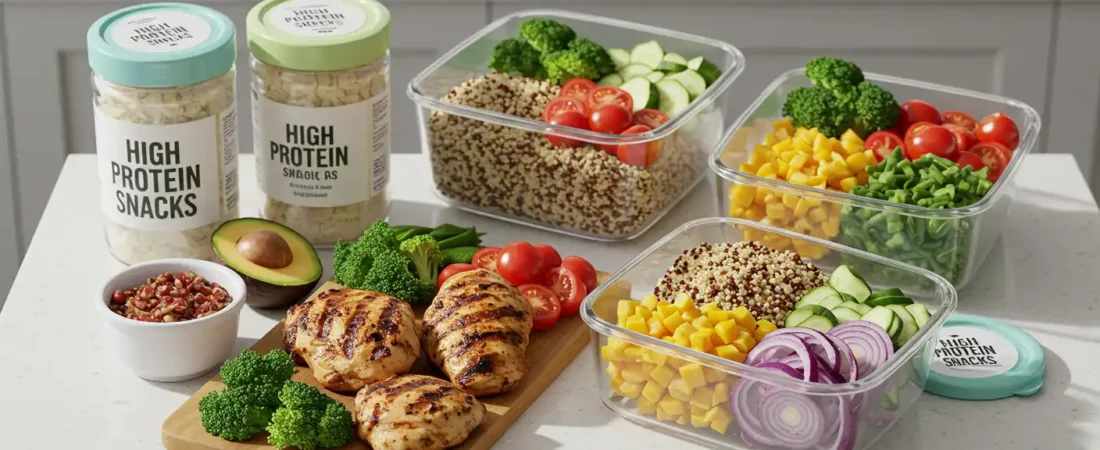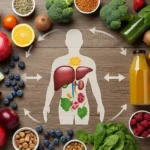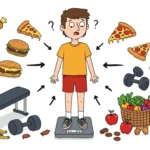Introduction
Safe weight loss healthy eating, calorie deficit, high protein foods, high protein snacks, and making smart choices around healthy food are crucial pillars for aiming to lose weight sustainably. From fitness beginners to seasoned weight watchers, crafting the right diet plan is one of the most powerful steps toward maintaining a healthy lifestyle.
Why Diet Matters for Safe weight Loss, It Is More Than You Think
Many people mistakenly believe that just exercising is enough to lose weight. However, science consistently shows that diet plays a much larger role. According to the CDC, while physical activity is important, creating a consistent calorie deficit through dietary choices is what leads to long-term weight loss. A healthy diet influences not only your weight but also your energy levels, sleep, focus, mood, and long-term disease risk. With so many benefits, adopting a sustainable and enjoyable eating plan becomes the foundation of a healthy lifestyle.
Understanding the Calorie Deficit – The Core of Safe Weight Loss
Living a healthy lifestyle begins with making informed decisions about what you eat and how you fuel your body. Whether you’re a seasoned weight watcher or just starting your wellness journey. Understanding the concept of a calorie deficit is essential for achieving sustainable safe weight loss and long-term well-being. Combined with healthy food choices, smart portion control, and the inclusion of high protein snacks and meals, this strategy can significantly enhance your overall fitness.
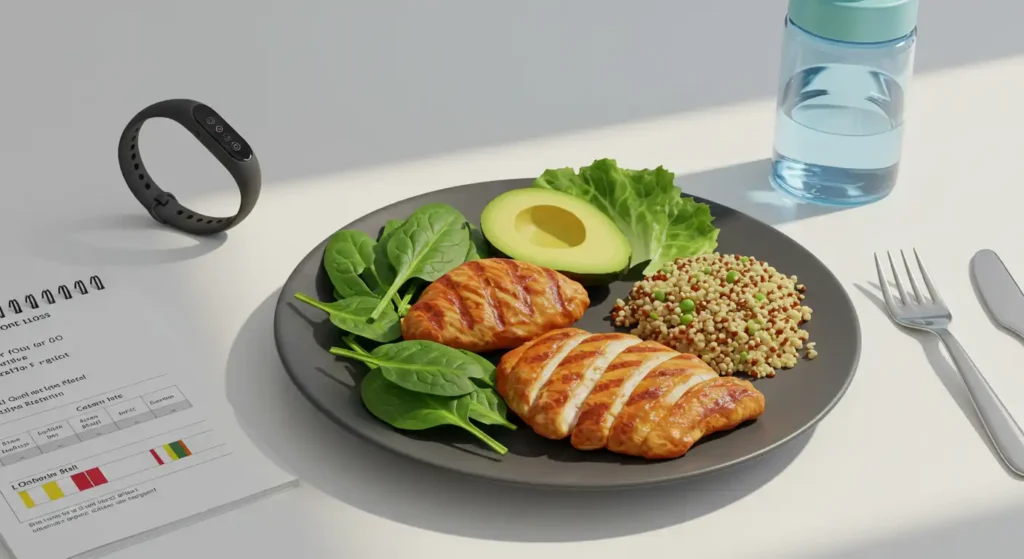
What Is a Calorie Deficit for Safe Weight Loss?
In simple terms, a calorie deficit occurs when you consume fewer calories than your body needs to maintain its current weight. Your body requires a certain amount of energy (measured in calories) for daily activities, including digestion, movement, and even rest. When you provide fewer calories than it needs, your body is forced to tap into fat stores for energy, leading to gradual and natural weight loss.
However, achieving a calorie deficit does not mean starving yourself or following restrictive diets. Instead, it involves making smarter food choices and embracing a balanced approach to nutrition. When done correctly, it becomes a cornerstone of a healthy lifestyle rather than a temporary fix.
How to Create a Sustainable Calorie Deficit for safe weight loss
1. Track Your Calories Consistently
To establish a calorie deficit, you must first know how many calories you’re consuming. Tracking apps like MyFitnessPal, Cronometer, or Lose It! can help you monitor your intake and stay within your daily calorie goals. These tools are especially useful for weight watchers aiming to stay accountable and make informed adjustments over time.
2. Choose Healthy Food Over Processed Options
Eliminating or reducing your intake of sugary, fried, and ultra-processed foods can dramatically cut unnecessary calories. Replace them with healthy food options such as:
- Whole grains (quinoa, brown rice)
- Leafy greens (spinach, kale, arugula)
- Fresh fruits and vegetables
- Lean sources of protein
3. Prioritize High Protein Foods
Including high protein foods like chicken breast, salmon, Greek yogurt, eggs, lentils, and tofu can keep you full for longer, prevent overeating, and preserve muscle mass during safe weight loss.
According to a study published in The American Journal of Clinical Nutrition: “Diets with higher protein content lead to greater weight loss, fat mass loss, and preservation of lean mass, along with improved cardiometabolic health outcomes over the short term, compared to lower-protein diets.“(source)
Furthermore, high protein snacks such as boiled eggs, cottage cheese, protein shakes, and roasted chickpeas are excellent choices between meals to keep hunger at bay without derailing your calorie goals.
4. Eat More Volume, Not Just Less Calories
One of the easiest ways to feel satisfied while staying in a calorie deficit is to focus on high-volume, low-calorie foods. Vegetables like zucchini, cauliflower, carrots, and lettuce can bulk up your meals, giving the sensation of a full plate without overloading on calories.
This is especially helpful for those following a weight watcher plan, as many of these foods are considered “zero points,” making them an ideal choice for creating satisfying, guilt-free meals.
Tips for Sticking to a Calorie Deficit Long-Term
- Stay hydrated: Sometimes thirst is mistaken for hunger.
- Plan meals in advance: This avoids impulsive food choices.
- Allow occasional indulgences: It’s about balance, not restriction.
- Exercise regularly: Combining cardio and strength training increases calorie burn and supports a healthy lifestyle.
Building Your Diet – What Should Be On Your Plate to Safe Weight Loss?
When pursuing a healthy lifestyle, especially while following a calorie deficit strategy, the inclusion of high protein foods becomes essential. Whether your goal is fat loss, muscle preservation, or simply maintaining energy levels throughout the day, protein-rich foods offer numerous benefits that extend far beyond basic nutrition. For weight watchers and anyone looking to make lasting health changes, understanding how to strategically include these foods can be a game-changer.
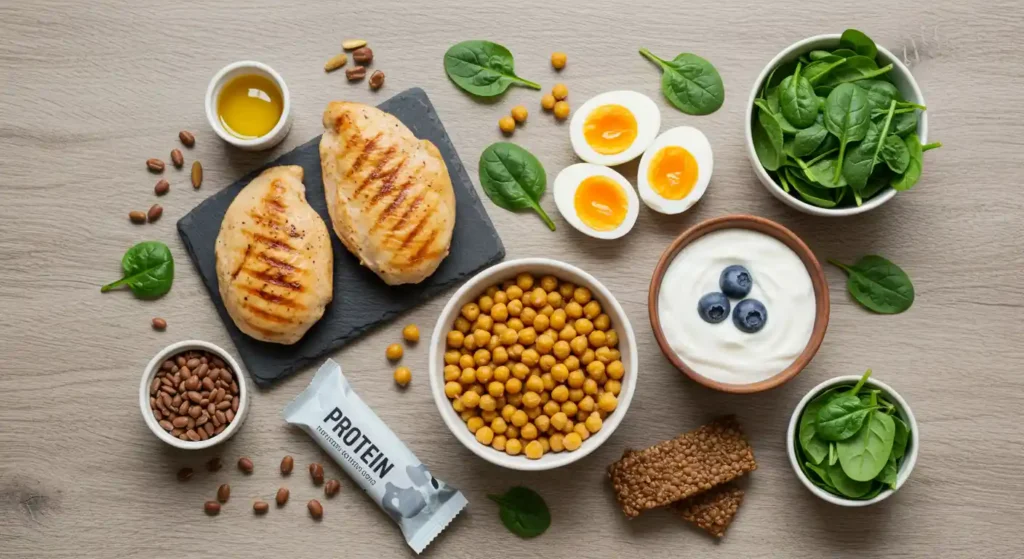
Why High Protein Foods Matter in a Calorie Deficit Diet for Safe Weight Loss
Protein plays a vital role in the human body especially when you’re in a calorie deficit trying to lose fat without sacrificing muscle mass. Unlike carbohydrates and fats, proteins serve as the building blocks of muscle, enzymes, and hormones, making them critical for recovery, metabolism, and overall physical performance.
Benefits of High Protein Intake
- Preserves Muscle Mass: During calorie restriction, your body may break down muscle tissue for energy. Adequate protein helps protect lean mass.
- Increases Satiety: Protein keeps you fuller for longer, helping control cravings and reducing total caloric intake throughout the day.
- Boosts Metabolism: The thermic effect of protein (TEF) is higher than carbs or fat, meaning your body burns more calories digesting it.
- Supports Recovery and Strength: If you’re pairing your diet with weight training or any form of resistance exercise, protein accelerates muscle repair and growth.
“High-protein diets have been shown to help with weight loss and maintenance, especially in conjunction with strength training.” — Harvard T.H. Chan School of Public Health
Best High Protein Foods to Include Daily
Incorporating a wide variety of high protein foods into your daily meals helps keep your nutrition diverse and your taste buds satisfied. Here are some of the most effective and nutritious sources:
Animal-Based Protein Sources
- Skinless Chicken Breast – Lean and versatile, ideal for meal prepping.
- Turkey – Another lean meat, great for sandwiches or salads.
- Tuna and Salmon – Rich in omega-3 fatty acids, supporting both heart health and metabolism.
- Low-Fat Greek Yogurt – High in protein and probiotics, perfect for breakfast or snacks.
Plant-Based Protein Sources
- Lentils and Beans – Rich in fiber and complex carbs in addition to protein.
- Tofu and Tempeh – Great meat alternatives that absorb flavor well.
- Edamame – A protein-rich snack with vitamins and minerals.
- Quinoa – A complete plant-based protein, making it excellent for vegetarians and vegans.
Don’t Skip High Protein Snacks
Snacking often gets a bad reputation in dieting circles, but high protein snacks can be incredibly beneficial especially for weight watchers and active individuals. When chosen wisely, snacks help prevent overeating during meals and provide steady energy throughout the day.
Top High Protein Snacks
- Boiled Eggs – Portable, affordable, and packed with nutrients.
- Cottage Cheese – Low in fat and high in casein protein, ideal before bed.
- Protein Bars (Low Sugar) – Great for on-the-go nutrition, especially post-workout.
- Roasted Chickpeas – Crunchy, satisfying, and plant-based.
- Beef or Turkey Jerky – Long shelf-life and easy to store; just watch the sodium content.
These snacks help you stay in a calorie deficit without feeling deprived and support your overall healthy lifestyle.
Load Up on Healthy Foods That Fuel Your Lifestyle
In addition to high protein foods, it’s crucial to fill your plate with healthy food options that are rich in vitamins, minerals, antioxidants, and fiber. The right combination of nutrients not only helps with safe weight loss but also boosts mood, energy levels, and immune function.
Healthy Food Staples to Include
- Fruits and Vegetables – Naturally low in calories and high in fiber, helping you feel full.
- Whole Grains – Options like oats, brown rice, and quinoa provide complex carbs and steady energy.
- Nuts and Seeds (in moderation) – Great for heart health and satiety.
- Avocados and Olive Oil – Healthy fats that support brain and hormone function.
Popular Safe Weight Loss Diets – What Works and What Doesn’t?
Adopting a healthy lifestyle often starts with what you put on your plate. While there’s no one-size-fits-all solution, certain dietary approaches have stood out for their proven results, ability to support a calorie deficit, and promotion of high protein foods, healthy food. Let’s explore four of the most popular diets that align with both weight loss and health goals especially for anyone identifying as a weight watcher.
Mediterranean Diet – A Heart-Healthy Way to Lose Weight
The Mediterranean diet has long been hailed as one of the world’s healthiest and most effective eating patterns. Rooted in the traditional cuisine of countries bordering the Mediterranean Sea, it emphasizes healthy food like olive oil, fish, vegetables, legumes, and nuts.
Why It Works
This diet is naturally rich in fiber, antioxidants, and healthy fats especially monounsaturated fats from olive oil and omega-3s from fish. These elements support cardiovascular health, reduce inflammation, and aid in weight control.
Moreover, the Mediterranean diet encourages mindful eating and balanced meals, making it easier to maintain a calorie deficit without counting every calorie.
According to a study published in The New England Journal of Medicine, the Mediterranean diet significantly reduced the risk of heart attacks, strokes, and death from cardiovascular causes.
Intermittent Fasting – Time-Based Eating for Fat Loss
Intermittent fasting (IF) is not a traditional diet but rather an eating schedule that alternates between fasting and eating periods. Popular formats include the 16:8 method (16 hours of fasting, 8 hours of eating) and the 5:2 approach (eating normally 5 days per week and restricting calories on 2 non-consecutive days).
Key Benefits and Considerations
Intermittent fasting can naturally lead to a calorie deficit because you eat fewer meals during the day. It also gives your digestive system a break and may improve insulin sensitivity.
However, it’s not suitable for everyone especially individuals with a history of disordered eating or certain medical conditions. Success depends largely on the quality of food consumed during eating windows, making high protein snacks and nutrient-dense healthy foods essential for sustained energy.
Low-Carb Diets (Keto & Atkins) – Rapid Results, Limited Flexibility
Low-carb diets like the ketogenic (keto) or Atkins plan focus on significantly reducing carbohydrate intake and replacing it with fat and protein. These diets can offer fast weight loss, especially in the early stages, by triggering ketosis a state where your body burns fat for fuel.
Pros and Cons
While low-carb diets are often rich in high protein foods like meat, eggs, and dairy, they can be restrictive and hard to maintain long-term. Social events, cravings, and lack of dietary fiber from fruits and whole grains can be a challenge for some.
Nonetheless, for individuals who respond well to a high-fat, low-carb approach, these diets can be effective for short-term safe weight loss and blood sugar management.
Weight Watchers (WW) – A Flexible Approach for Real-Life Eating
Weight Watchers, now rebranded as WW, is a globally recognized program designed for sustainable, real-life weight loss. Rather than strictly eliminating certain foods, WW uses a point system to guide people toward healthy food choices, portion control, and consistency.
What Makes WW Effective
WW promotes a healthy lifestyle by encouraging whole foods, lean proteins, and high protein snacks while still allowing occasional indulgences. This flexibility makes it easier for users to stay on track long-term without feeling deprived.
Many people find the community support, accountability tools, and structured coaching to be valuable motivators in their journey toward weight loss and better health.
Common Dieting Mistakes That Sabotage a Healthy Lifestyle and Calorie Deficit Goals
Maintaining a healthy lifestyle and achieving a calorie deficit require more than just following a meal plan. While many people focus on eating high protein foods, enjoying healthy food, and choosing smart high protein snacks, there are common mistakes that can quietly derail progress. Whether you’re a seasoned weight watcher or just starting your fitness journey, avoiding these pitfalls can be the difference between long-term success and frustration.
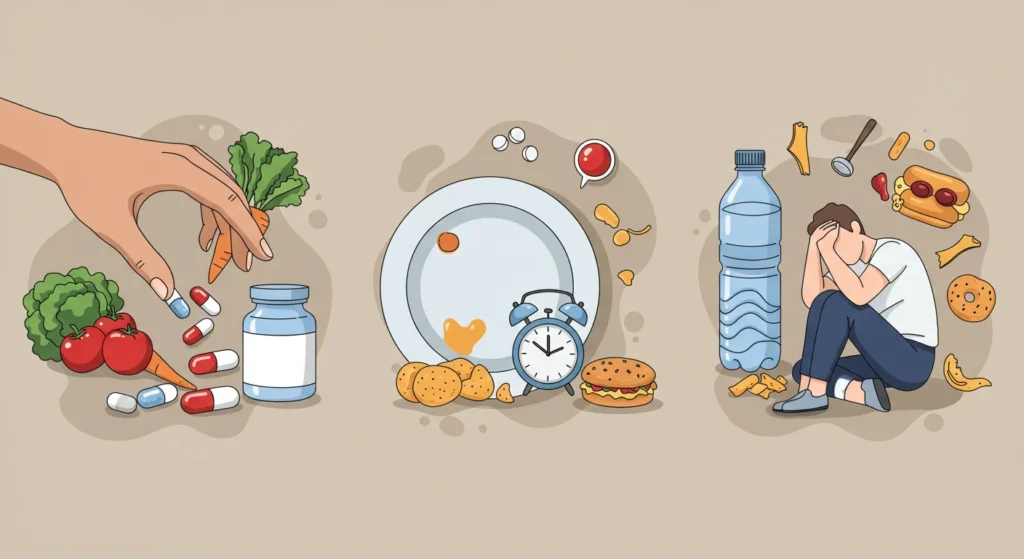
Mistake #1 – Relying Solely on Supplements Instead of Whole Healthy Foods
In today’s fast-paced world, it’s tempting to substitute real meals with shakes, pills, or powders. While some supplements can be helpful like protein powders or vitamin D they should never replace nutrient-rich healthy food.
Why This Hurts Your Progress
Supplements often lack the fiber, antioxidants, and complex nutrients found in whole foods. Relying on them may leave you feeling unsatisfied, leading to cravings or snacking binges later on. It also hinders your body’s ability to absorb nutrients effectively. Instead, focus on building meals around high protein foods, vegetables, whole grains, and healthy fats to stay full and energized.
“Real food is more than the sum of its nutrients. Whole foods are synergistic and support better health outcomes than isolated nutrients alone.” – Harvard T.H. Chan School of Public Health¹
Mistake #2 – Skipping Meals and Binge Eating Later
Skipping meals may seem like a shortcut to achieving a calorie deficit, but this approach often backfires. When you skip breakfast or lunch, you’re more likely to overeat later in the day, which can sabotage your efforts to maintain a healthy lifestyle.
The Better Approach
Instead of skipping meals, aim for balanced meals throughout the day. Include high protein snacks like boiled eggs, Greek yogurt, or roasted chickpeas between meals to keep your hunger in check. This not only stabilizes your blood sugar levels but also helps you maintain a more controlled appetite.
Mistake #3 – Not Drinking Enough Water
Hydration is often overlooked, yet it plays a crucial role in weight management and overall health. Many people confuse thirst with hunger, leading to unnecessary calorie consumption.
Hydration Tips for a Healthy Lifestyle
Drink a glass of water before each meal, aim for at least 2 liters per day, and increase your intake if you’re active or live in a hot climate. Staying hydrated also aids digestion and supports your body’s ability to burn fat efficiently.
Mistake #4 – Ignoring Sleep and Stress Levels
Even if you’re eating the right high protein foods and maintaining your calorie deficit, poor sleep and chronic stress can sabotage your efforts. Lack of sleep disrupts hunger hormones, making you crave unhealthy food and increasing the likelihood of overeating.
Balance Your Body and Mind
Aim for 7–9 hours of quality sleep per night, and find healthy ways to manage stress such as exercise and meditation. These habits support hormonal balance, enhance energy, and reinforce your healthy lifestyle goals.
Final Thoughts
Avoiding these common mistakes can significantly improve your results and make your journey toward a healthy lifestyle much more sustainable. Remember: consistency, balance, and self-awareness are the keys. Focus on nourishing your body with healthy food, choosing quality high protein snacks, maintaining your calorie deficit, and practicing holistic self-care.
Sample One-Day Healthy Meal Plan to Support a Calorie Deficit and Sustainable Lifestyle
Creating a realistic and enjoyable eating routine is key to sustaining a healthy lifestyle. Whether you’re following a weight watcher-style plan, tracking macros, or just aiming to eat better, a well-structured day of eating with high protein foods, nutrient-dense ingredients, and smart healthy food choices can help you stay on track.
Below is a sample one-day healthy meal plan designed to maintain a gentle calorie deficit while keeping you satisfied, energized, and fueled for success. This plan prioritizes high protein snacks, fiber-rich carbohydrates, and healthy fats perfect for anyone pursuing long-term wellness.
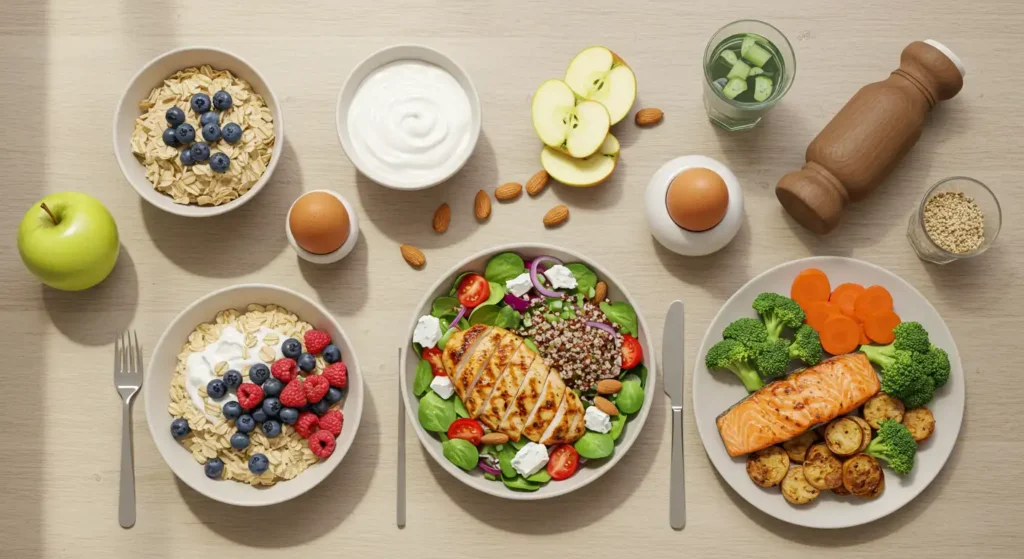
Breakfast – Power Up Your Day the Healthy Way for safe weight loss
Oatmeal with chia seeds, berries, and a scoop of protein powder
Start your day strong with a combination of complex carbs, fiber, antioxidants, and protein. Oatmeal provides slow-digesting energy, while chia seeds add omega-3s and extra fiber. Adding berries boosts antioxidants and flavor, and protein powder transforms your breakfast into a muscle-supporting powerhouse.
Why It Works
This meal balances macronutrients and helps you avoid mid-morning energy crashes key for a sustainable calorie deficit and a healthy lifestyle.
Morning Snack – High Protein Snack to Keep Hunger at Bay
Boiled eggs + a small apple
This combo delivers high-quality protein and healthy fats from eggs, plus fiber and natural sweetness from the apple. It’s a portable, budget-friendly high protein snack that helps curb cravings and supports muscle maintenance.
Expert Tip
Including a protein-rich snack like this between meals can help regulate appetite and reduce the risk of overeating later in the day.
Lunch – A Balanced Plate Full of Healthy Food and Flavor
Grilled chicken salad with olive oil and quinoa
This midday meal hits all the nutritional marks: lean protein (grilled chicken), healthy fats (olive oil), complex carbs (quinoa), and a rainbow of vegetables. It’s satisfying without being heavy ideal for those aiming to support fat loss while nourishing the body.
Pro Tip
Opt for dark leafy greens like spinach or kale for added micronutrients, and drizzle olive oil for heart-healthy monounsaturated fats.
Afternoon Snack – Greek Yogurt with Almonds: A Protein and Crunch Combo
Greek yogurt with almonds
Greek yogurt is a staple among high protein foods, packed with probiotics and essential amino acids. Almonds add crunch, healthy fats, and satiety. Together, they create a satisfying snack that keeps energy stable throughout the afternoon.
Weight Watcher Friendly
This snack is perfect for portion control and aligns with many weight watcher point systems due to its nutrient density.
Dinner – Nourishing and Light for Evening Wellness
Baked salmon, sweet potatoes, and steamed broccoli
Dinner should be nourishing but not overly heavy. Salmon provides omega-3 fatty acids and protein, sweet potatoes offer complex carbs and fiber, while broccoli supplies antioxidants and essential vitamins.
Why It Supports a Healthy Lifestyle
This meal promotes muscle recovery, supports brain function, and aligns with long-term weight management strategies.
🧠 *According to the American Heart Association, consuming fatty fish like salmon twice a week supports cardiovascular health and weight control.
Final Notes
This healthy meal plan supports a balanced lifestyle, promotes satiety with high protein foods, and helps maintain a sustainable calorie deficit. Plus, it’s rich in healthy food options and includes high protein snacks that are easy to prepare and enjoyable to eat. Whether you’re a seasoned weight watcher or just starting your journey toward better health.
Lifestyle Tips to Support Long-Term Safe Weight Loss and a Healthy Life
Stay Active Consistently – Move Your Body for a Better Lifestyle
Staying physically active is a cornerstone of successful and sustainable weight management. According to the CDC, adults should aim for at least 150 minutes of moderate-intensity aerobic activity per week, such as brisk walking, swimming, or cycling.
Why It Works
Combining cardio with strength training (like using high protein foods to rebuild muscle) enhances fat burning, boosts metabolism, and preserves lean body mass. This synergy supports both short-term weight loss and long-term health.
Pro Tip:
If you’re short on time, try breaking your workouts into 10- to 15-minute sessions throughout the day it all adds up!
Prioritize Quality Sleep – Your Secret Safe Weight Loss Ally
Getting enough restful sleep isn’t just good for energy levels it also plays a critical role in hunger regulation and fat loss. Studies have shown that sleep deprivation increases ghrelin, the hormone that makes you feel hungry, and decreases leptin.
Actionable Advice
Aim for 7–9 hours of sleep per night. Establish a relaxing bedtime routine, reduce screen time before bed, and keep your sleep environment cool and dark to improve sleep quality.
🧠 Research published in the journal Obesity Reviews confirms the link between poor sleep and increased calorie intake, particularly from high-fat and high-sugar foods.
Manage Stress Effectively – Protect Your Healthy Lifestyle from Emotional Eating
Stress, when unmanaged, is one of the biggest triggers for emotional eating and unhealthy food choices. Chronic stress increases cortisol levels, which can promote fat storage, especially in the abdominal area, and lead to poor eating habits.
How to Manage It
Incorporate daily stress-reducing activities such as:
- Deep breathing or meditation
- Walking outdoors or light exercise
- Talking to a friend or therapist
- Journaling or reading
Mindfulness helps you stay present, recognize true hunger cues, and avoid turning to food for comfort.
Hydration Is Key – Drink More, Weigh Less
Often overlooked, proper hydration is crucial for safe weight loss and overall health. Dehydration is frequently mistaken for hunger, leading to unnecessary snacking and extra calories.
Hydration Guidelines
Drink at least 8 cups (2 liters) of water per day, and more if you’re physically active or live in a hot climate. Start your day with a glass of water and keep a refillable bottle with you throughout the day to stay on track.
Conclusion: Embrace a Healthy Lifestyle With Confidence for Safe Weight Loss
Maintaining a healthy lifestyle and managing your weight successfully isn’t about perfection it’s about making small, consistent changes that align with your long-term goals. By staying active, sleeping well, managing stress, and staying hydrated. You’re not only reinforcing your calorie deficit but also promoting overall wellness and better quality of life. These lifestyle habits, when combined with nutritious high protein foods, smart high protein snacks, and plenty of healthy food, can make all the difference in achieving a sustainable, weight watcher-friendly routine.
🎯 Ready to Transform Your Life? Start Your Healthy Lifestyle Today!
